This year’s Svenska Cupen final was played without spectators because of the COVID-19. Maybe, this could nullify the home advantage as the game was played at the home ground of IFK Goteborg – Gamla Ullevi. If Malmo FF won the cup, this would be a great boost to their title race with IFK Norrköping in Allsvenskan.
However, despite taking the lead before the halftime, Malmö failed to protect it and Göteborg equalized before the final whistle. In the extra time, the home team scored the winning goal and won the 13th Svenska Cupen in the club history.
So, what happened in this game? In this tactical analysis, we will dissect all key elements and tactics of both managers – Poya Asbaghi and Jon Dahl Tomasson.
Lineups
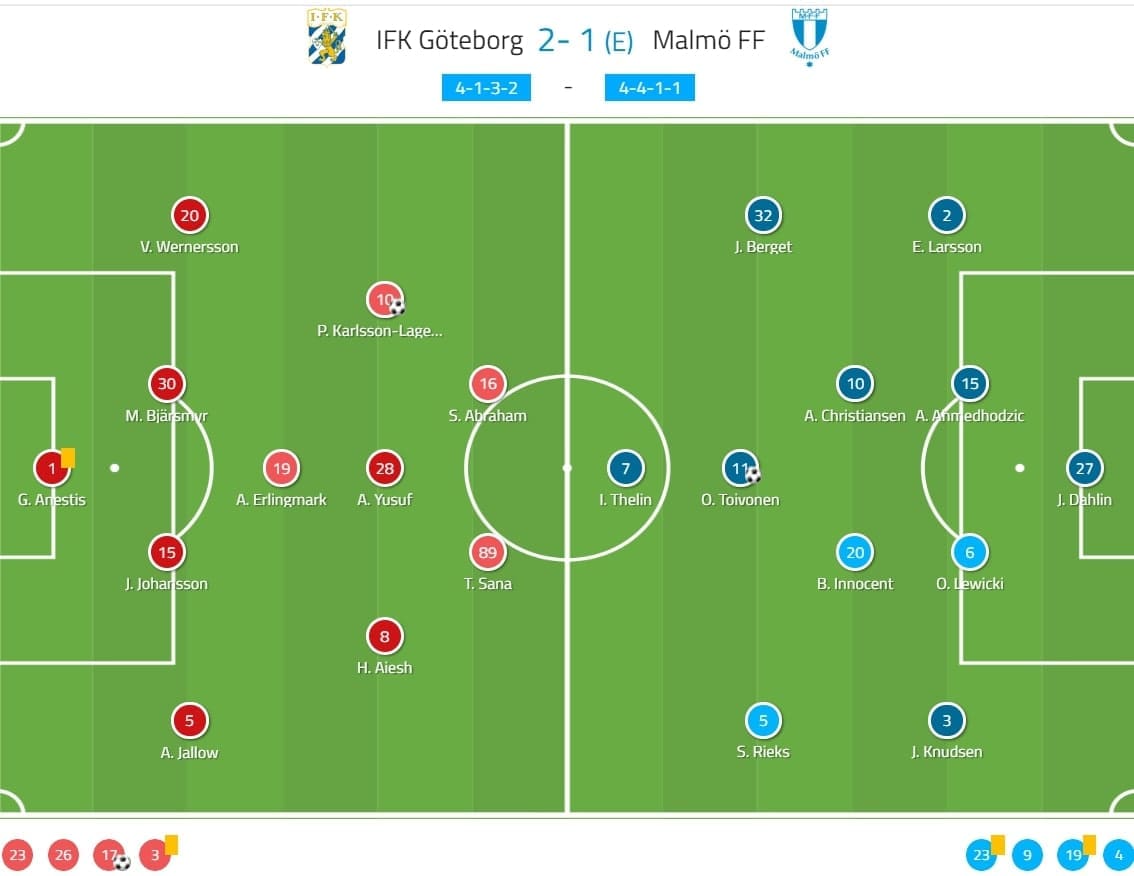
Göteborg (4-1-3-2): Giannis Anestis; Alexander Jallow, Jakob Joharsson, Mattias Bjärsmyr, Victor Wernersson; August Erlingmark, Hosam Aiesh, Patrick Karlsson-Lagemyr; Tobias Sana, Sargon Abraham
Malmö (4-4-1-1): Johan Dahlin; Eric Larsson, Anel Ahmedhodžić, Oscar Lewicki, Jonas Knudsen; Jo Inge Berget, Anders Christiansen, Bonke Innocent, Søren Rieks; Ola Toivonen; Isaac Kiese Thelin
Malmö attack with the free player
Before analyzing how Tomasson’s men attacked, we have to understand the defensive scheme of the opponent, including the strengths and weaknesses. In my previous analysis, I stressed the importance and threat of Toivonen in Malmö’s positional plays. It seems the coaching staff of the Göteborg were also aware of this, they were trying to limit the former Sunderland man.
The press of Göteborg was interesting, mostly committing five players high and it was a man-orientated scheme. The most important man-marking part was the midfield, where Malmö had three players there. A midfielder should drop deeper to mark Toivonen, while the other two targets (Christiansen and Innocent) marked by the far-side winger and another midfielder. The ball-side winger should close the ball-side full-back, while the strikers were pressing the centre-backs in a 2-2.
The shape was illustrated with this image. As you may notice, one Malmö full-back could be free under this pressing scheme, who was usually the player on the far-side. The ball was on the left in this instance, so Larsson became the free player as the Göteborg winger came narrowly to approach Christiansen.
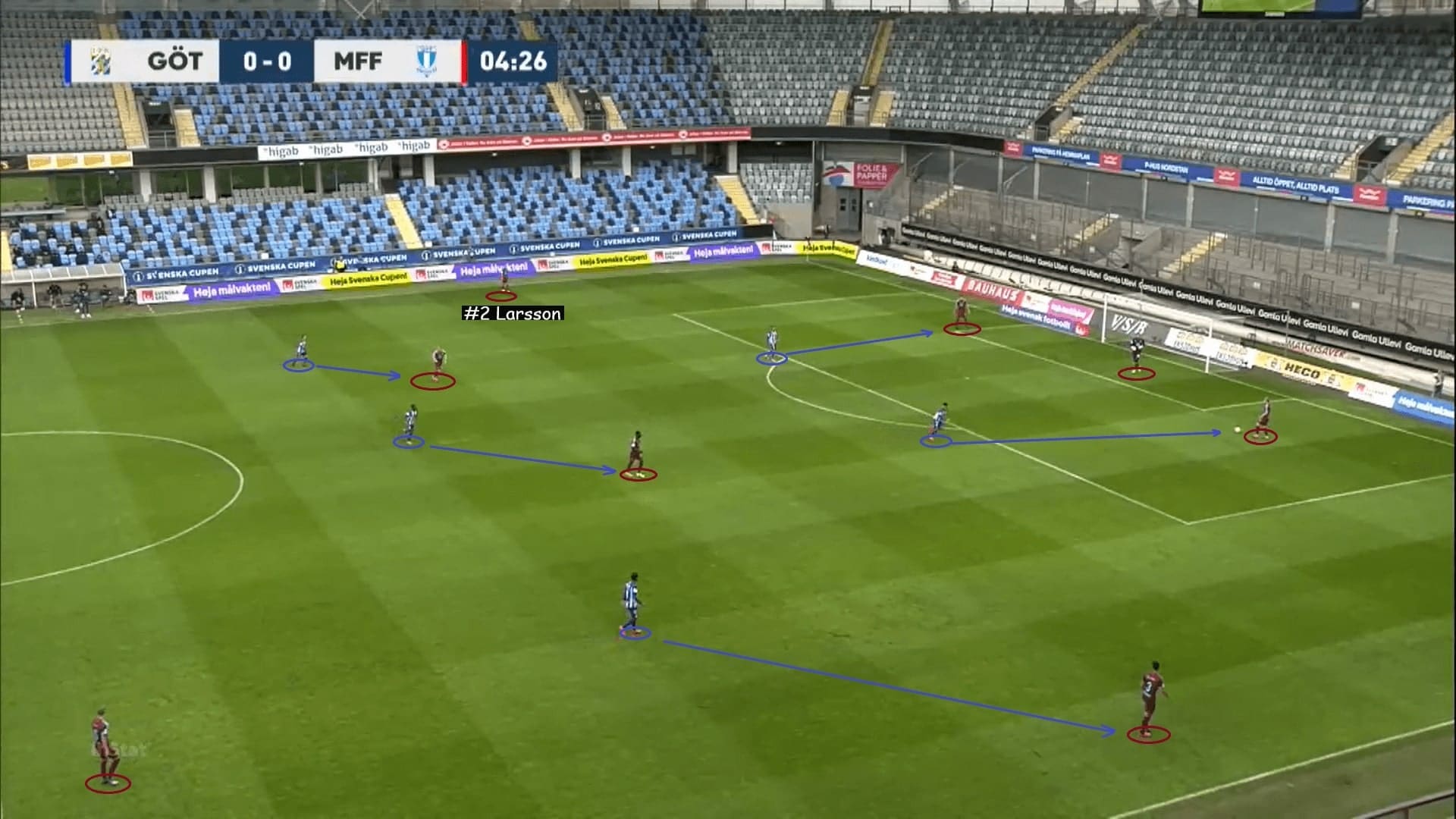
Since we pointed out the very clear loophole of the press, Malmö were mostly attacking with this free player, combining with their extremely strong ball circulation ability. In general, the build-up shape was a 4-4-2, with Christiansen having the freedom to drop into the half-spaces or replacing Larsson temporarily. The entire backline was extremely wide to maximize the playable area horizontally, this made the opponents difficult to cover every player – ensuring a free player was available.
In this example, the pitch is divided into two imaginary vertical halves. You will discover the majority of Göteborg players were on the ball-side, leaving the far-side full-back unmarked. Since the markings were not tight enough to press the receiver immediately, Malmö were comfortable to circulate the ball given the technical players in the squad. Lewicki quickly played the ball to Larsson, who served as the option to progress the ball.
Covering Toivonen at the expense of allowing a free full-back, it was a pretty smart approach as Larsson was less threatening comparatively. At times, the out-balls from the right-back were difficult to control, hence, the hope was mainly on the physical presence of Kiese Thelin.
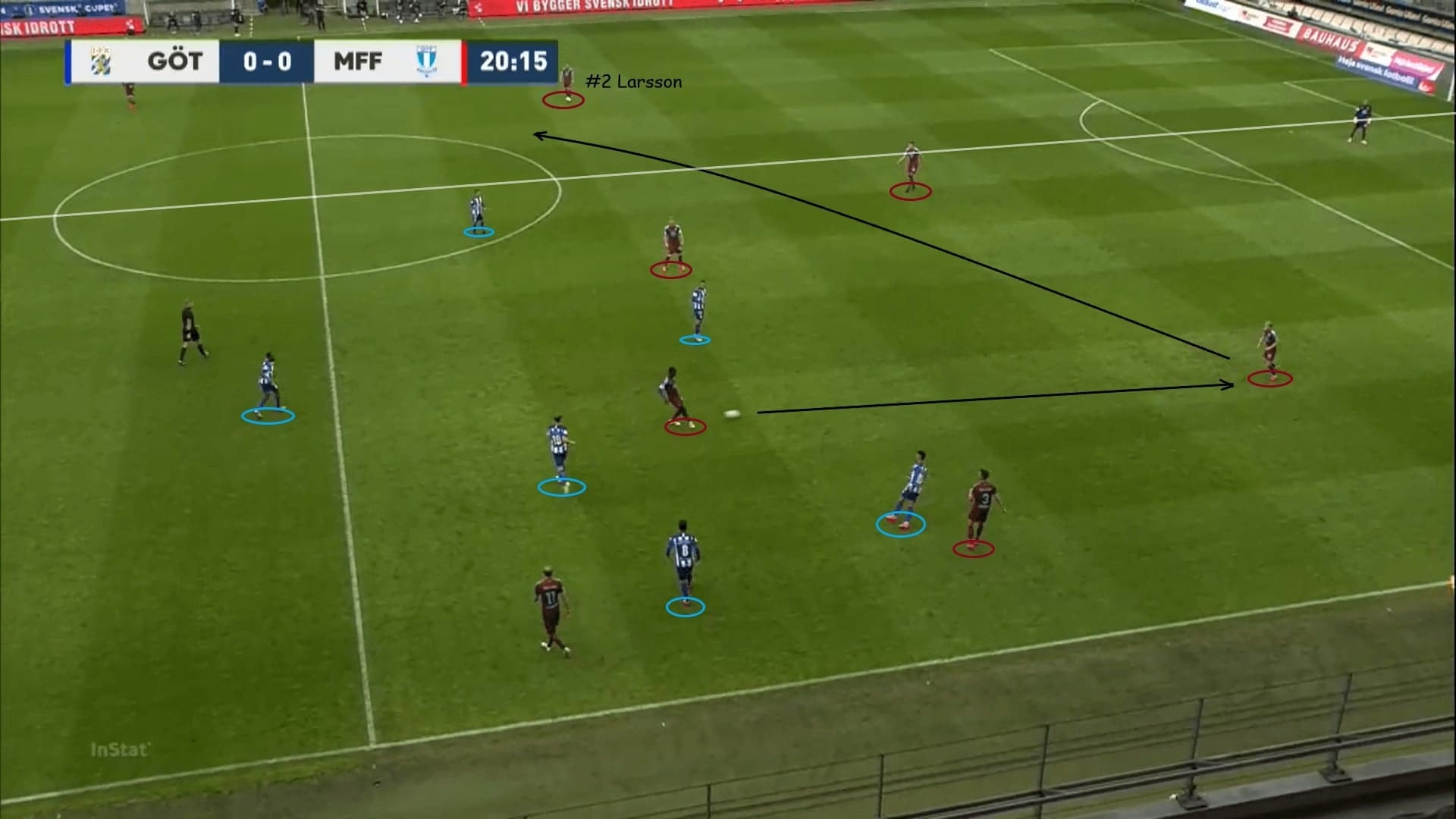
Since Lewicki injured and he was replaced by Behrang Safari, who was less comfortable on the ball, Tomasson adjusted the build-up a bit by dropping Christiansen to the first line. This was also a strategy to counter the man-marking defence of Götebrg, as the opposition midfielders were reluctant to leave the position too far.
Now, the build-up shape of Malmö was more like a 3-2 at the centre, as Toivonen dropped alongside Innocent to free himself. The first layer with three-man would always overload the two pressing strikers. In other words, at least there was a free player in this setup, who could be the wide centre-back that develop the attack, connecting the wide players.
If the centre-backs occupied the strikers, this would allow Christiansen to pass the ball with greater spaces and a better passing angle. The passing range of the former Chievo Verona player is really large, which could potentially send the ball nearby the offensive third.
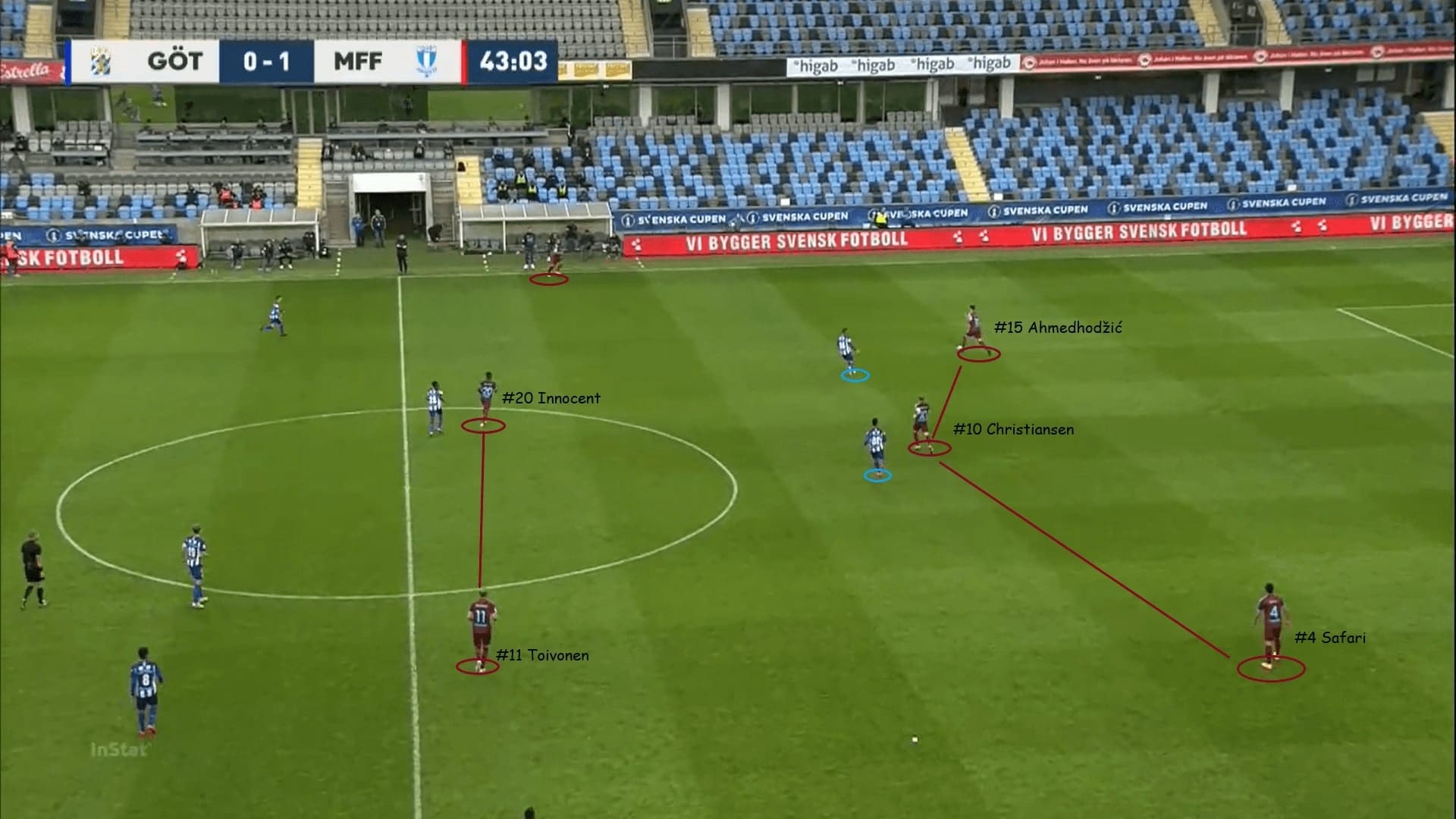
In the second half, Malmö faced some difficulties when developing the attacks, the opponents have noticed the issues in the first half and amended them. The above analysis suggested the far-side full-back was the man to bypass the press, and, what Göteborg did was to eliminate this player.
This was done by committing the full-back early to pressure the full-back. Here, the Göteborg left-back jumped to Larsson immediately, forced the Malmö right-back to play the ball without time to adjust the body orientation. Larsson was forced to use his weaker foot to play the ball, as expected, the quality was lower and the opponents were more likely to intercept.
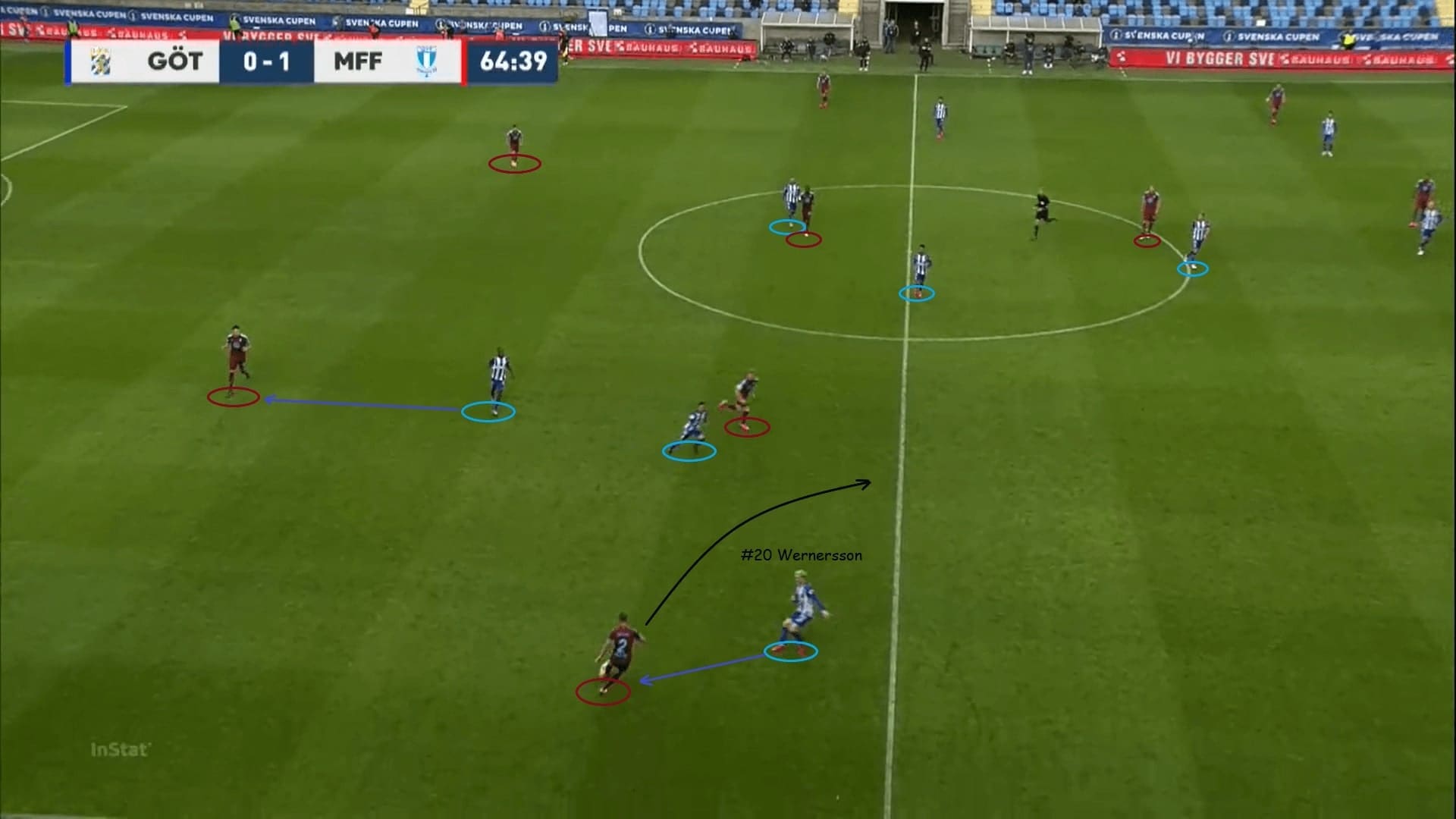
Another issue we would raise was the use of false-wingers. As usual, Inge Berget operated narrowly when other midfielders dropped deep, being the man to provide the passing option at the centre. However, if he went too deep, the supportive runs are unlikely to happen and the attacks might lose continuity.
Since Göteborg were pressing tighter in the second half, Malmö had to use more players in the build-up. Also, we have pointed out Toivonen also dropped alongside Innocent more often, so Inge Berget moved to the centre very naturally to fill that position. This was how the Malmö right-winger connected the play and moved the ball to the free player – Larsson below.
Wernersson came quickly again, again, this might not be an issue if the right-back is a player like João Cancelo or Ricardo Pereira. However, given the player was Larsson, who was 29-year-old already, lacked physical and qualitative superiorities, hardly could we expect any successful runs with the ball to enter the final third.
On most cases, Larsson could only pass, but without a viable supporting player, he tended to throw some long balls forward without a clear purpose. This was also suboptimal as Kiese Thelin was more like a target man, he was not that type of player to run behind the defence. Even Göteborg hold a high line of defence, Malmö did not exploit those spaces.
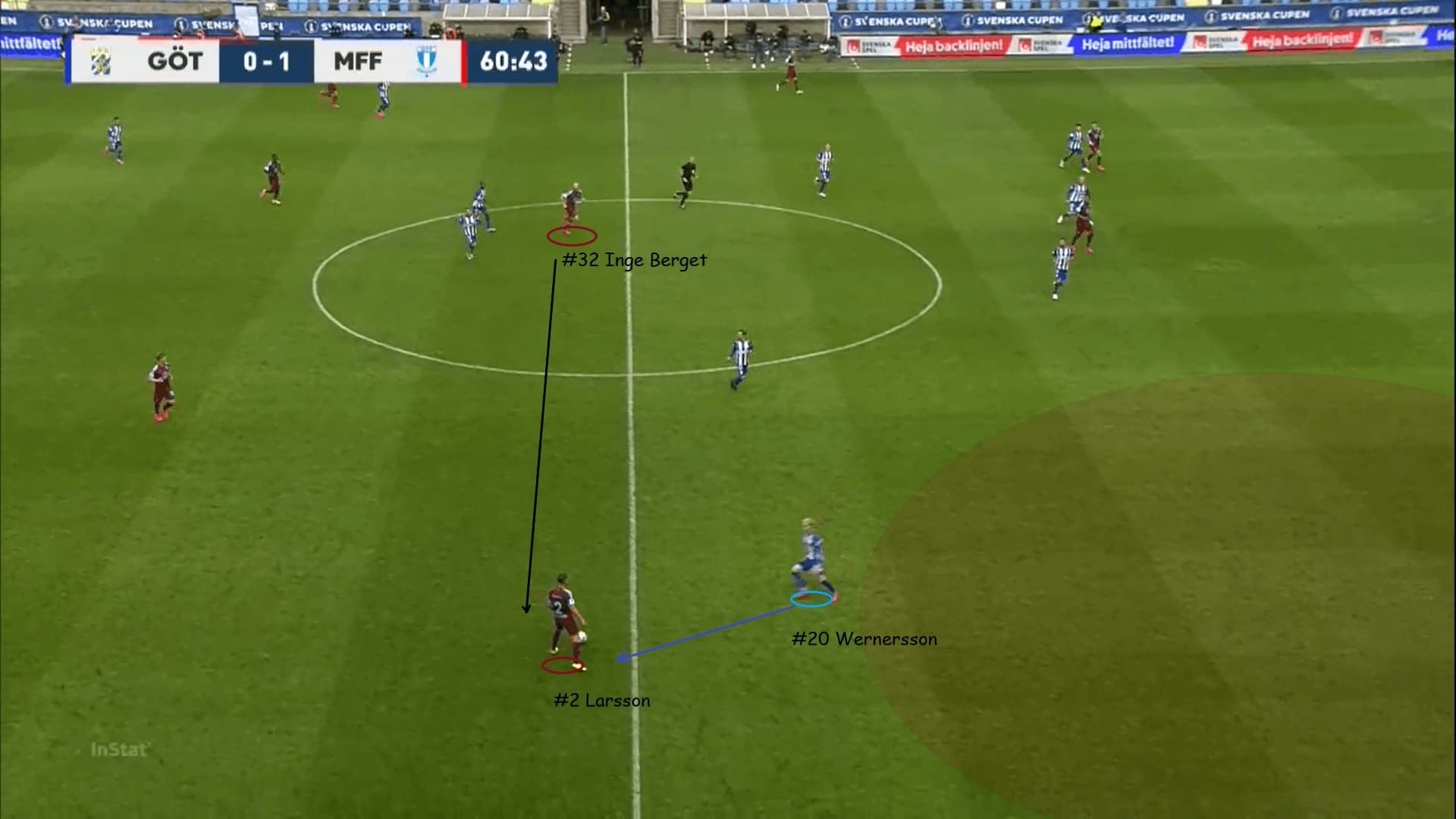
Into the extra time, it was not about how to play out from the back anymore, especially when the home side has taken the lead. Keeping the ball at the backline for a long time would only allow Göteborg to move 10 players in front of the penalty box.
Now, the game of Malmö is much more direct. Apart from those throw-ins by Knudsen, Larsson was the player who always tries finding Kiese Thelin. Also, Christiansen pushed to the forward line and attacking, as well as Antonsson staying narrowly to pick the second balls.
But, similar to the above scenarios, the long-passing or crossing quality of Larsson is not good enough to create dangerous situations directly. Sometimes the dropping point of the ball was too deep while sometimes Kiese Thelin could not guide the ball as he wished.
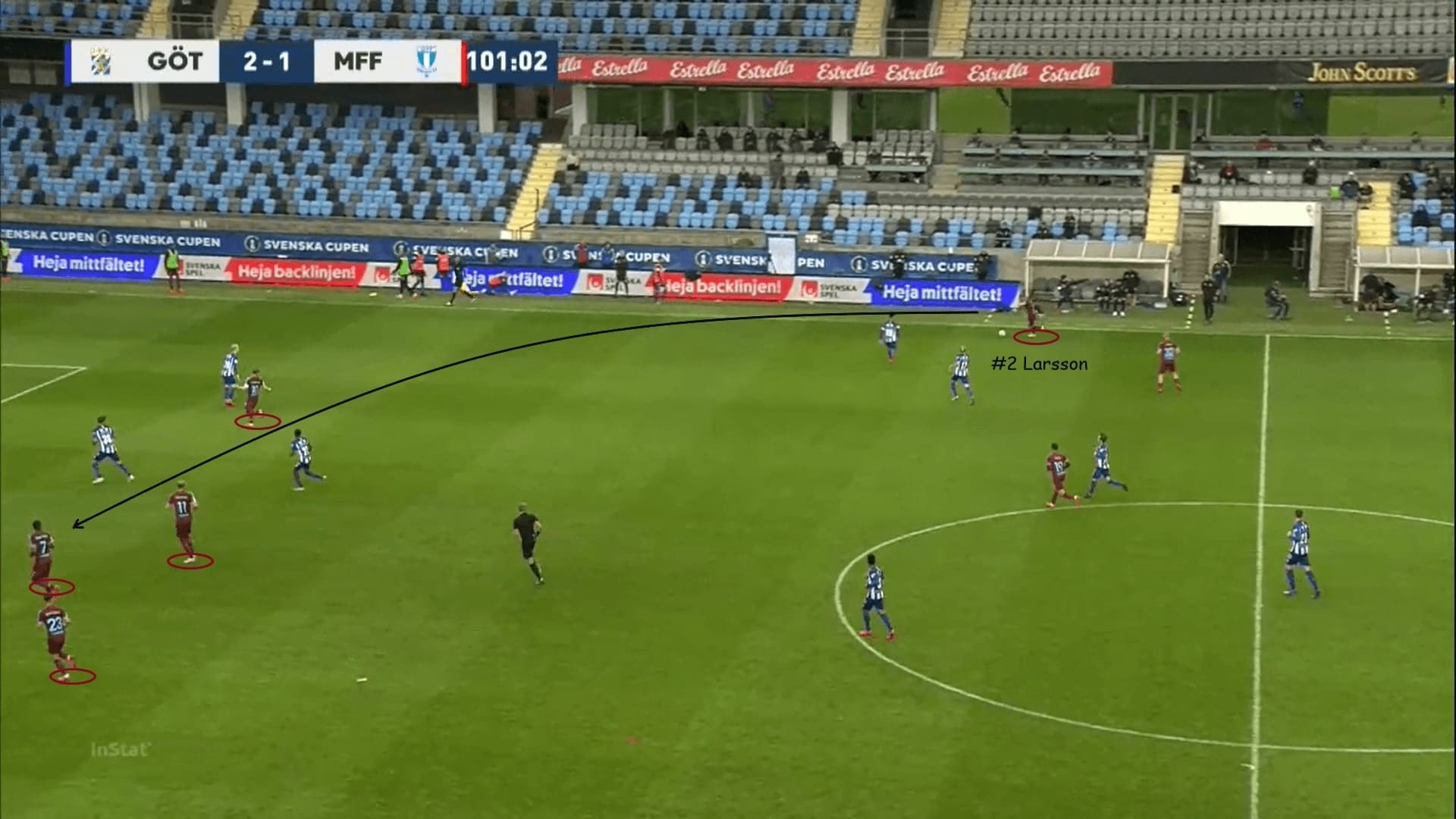
Similar defensive system – different focus
The defensive system of Malmö was a bit similar to the opponent, also like a 4-1-3-2 shape as Innocent provided the additional layer. However, the focus and setup of this scheme were very different from Göteborg, it was more zone-orientated. They needed a complete back four at the defence to ensure a 4 v 3 numerical overload against the opponent.
Toivonen usually joined Kiese Thelin to form the first line of the defence, the former Toulouse man was strong at linking plays as well. Therefore, it would be a great advantage if Toivonen was available in the offensive transitions. The second layer was formed by three players, which was a bit weak in terms of the horizontal coverage. This potential issue was eased because of the coverage of the first line and the pressing trap we are going to explain.
Therefore, the Göteborg far-side players were free, but Asbaghi’s side clearly did not possess the same ability to circulate the ball as Malmö did. The build-up was greatly constrained because of Di blåe.
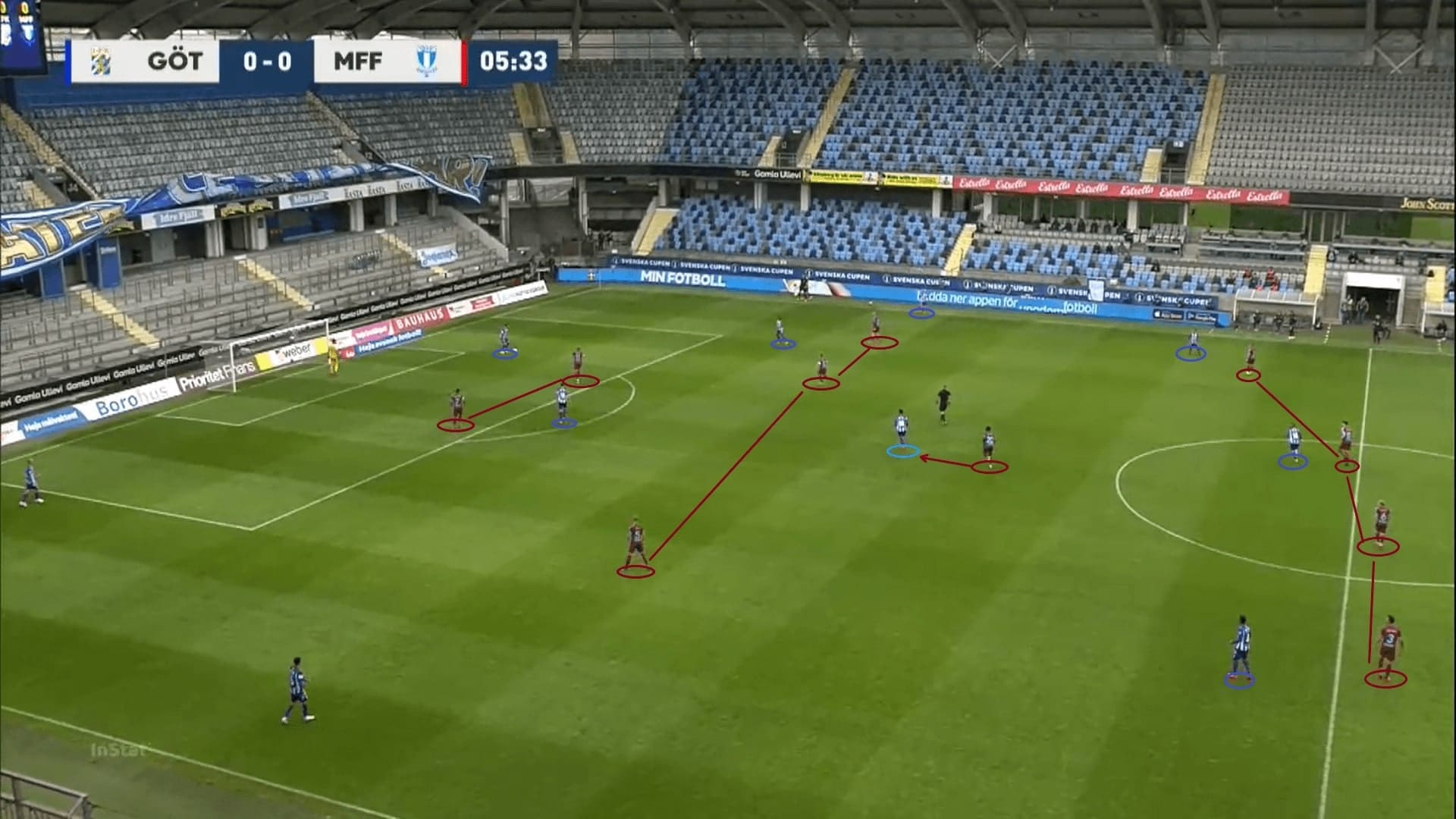
In my previous analysis in the win over Sirius, I mentioned the defensive behaviour of Inge Berget and believed it is a two-sided coin. In this game, the Malmö right-winger’s attention often went to the wide player and liked to adjust his body towards the flank very early. This was viewed as a loophole of the pressing system, but the situation was much better in the Svenska Cupen final.
The habit of Inge Berget did not change, what polished the defence was the compactness. The close proximity of players has turned this deficit into a benefit, a pressing trap was set because of this. The Göteborg full-backs and wingers were cleverly occupying to vertical zones, through the rotations, a temporarily overloading on the Malmö full-back was created.
In this example, Inge Berget was wider because of the wide full-back, which opened the passing lane to the winger, not sure it was intentionally or not. However, Göteborg seldom progressed in these situations given the immediate pressure triggered by this pass – the receiver was surrounded by three Malmö players from three angles, difficult to keep the ball.
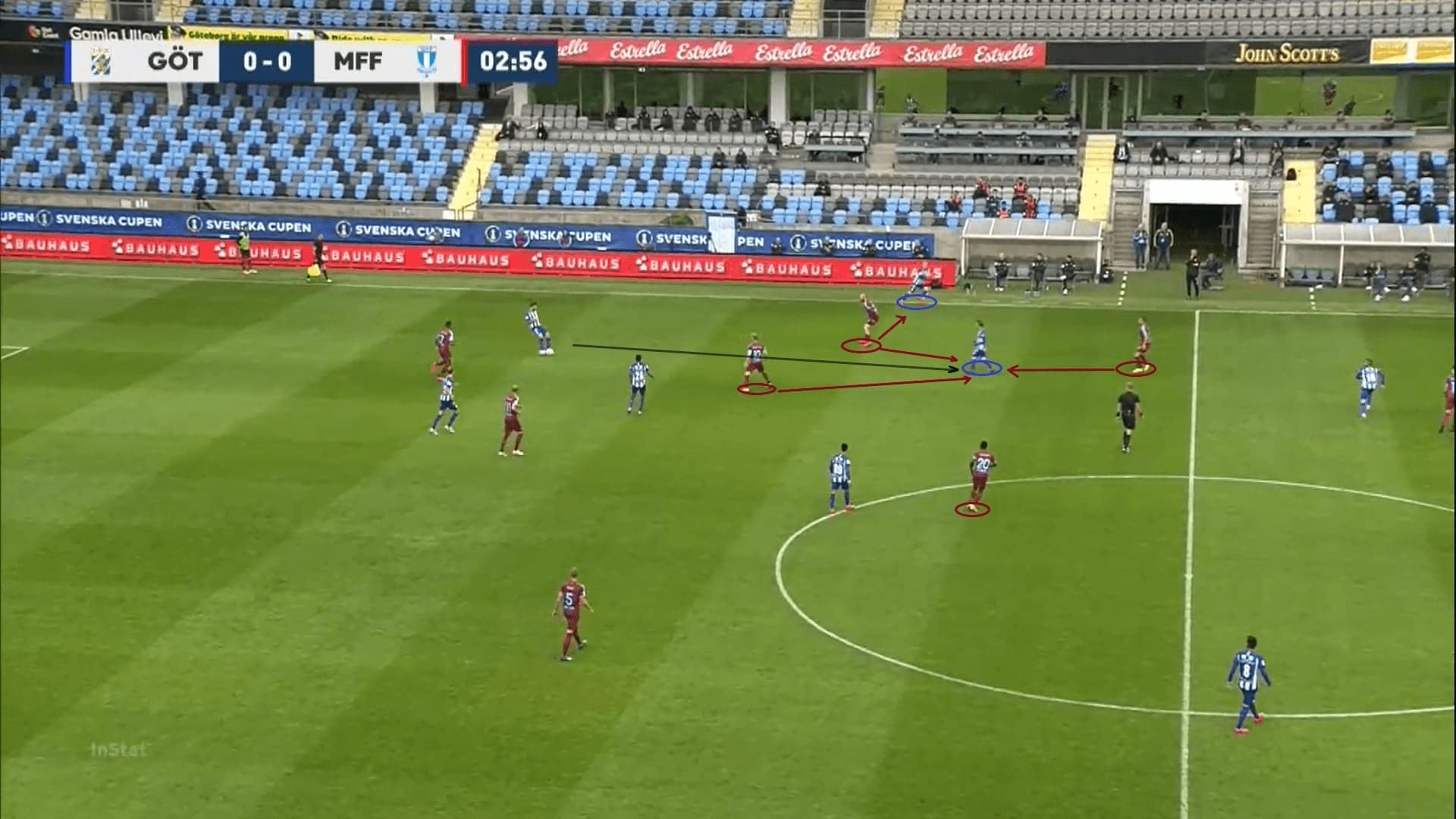
In the second half, Malmö were more conservative as they tried to protect the lead. It was more likely to form a 4-4-2 midblock at the centre (or 4-4-1-1, depending on Toivonen). The below case was an exception as Innocent just returned from the sideline, Toivonen temporarily replaced the Nigerian player.
In general, the block was quite compact horizontally as they mostly occupied the central zones. However, it was imperfect because of several reasons. The engagement line was too low, Kiese Thelin was less effective in terms of pressing the ball after the break, a concern that we are addressing in the below section.
Speaking of individuals, Christiansen has a habit to leave his position, maybe slightly staying higher. Spaces between the lines would be generated and the opponents could play the ball into these areas. Therefore, this required the centre-backs to cover without hesitation – like Ahmedhodžić covered Christiansen below.
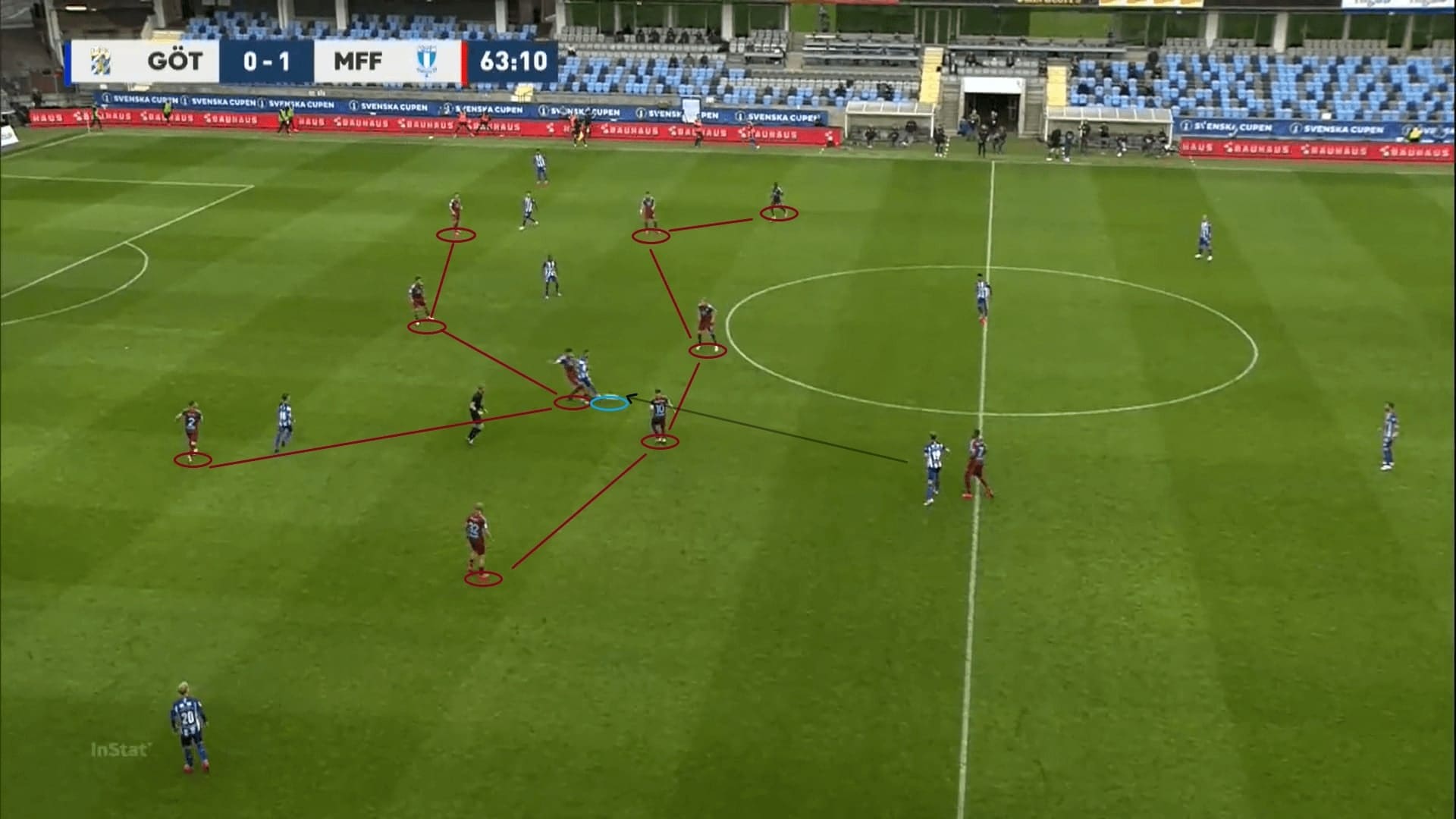
Göteborg using the gaps to attack
In cases that Göteborg were able to hold the ball under the press, they also had the strategies to develop the attack into the more advanced area on the pitch. The fully capitalize on the weak spot of a three-man defensive line, which was lacking horizontal coverage as mentioned.
When the first wave or second wave of pressure did not work, Malmö dropped deeper to form a midblock, in a 4-4-2 shape. Something unchanged was the close proximity of the second line, where they placed mostly three midfielders to shadow the ball-side. In other words, the defence was outnumbered on the far side.
Göteborg used a pair of wide full-backs, trying to stretch the defence of Malmö and create some horizontal gaps. This was a successful strategy that helped the team to arrive at the final third at times. As an example, when Blåvitt switched the ball to the centre-back’s feet, the defender could bring the ball forward without facing the pressure. This was thanks to the presence of the wide right-back, who fixed Rieks’ attention and dragged him wider, opened spaces at the centre. This was where the winning goal was from.
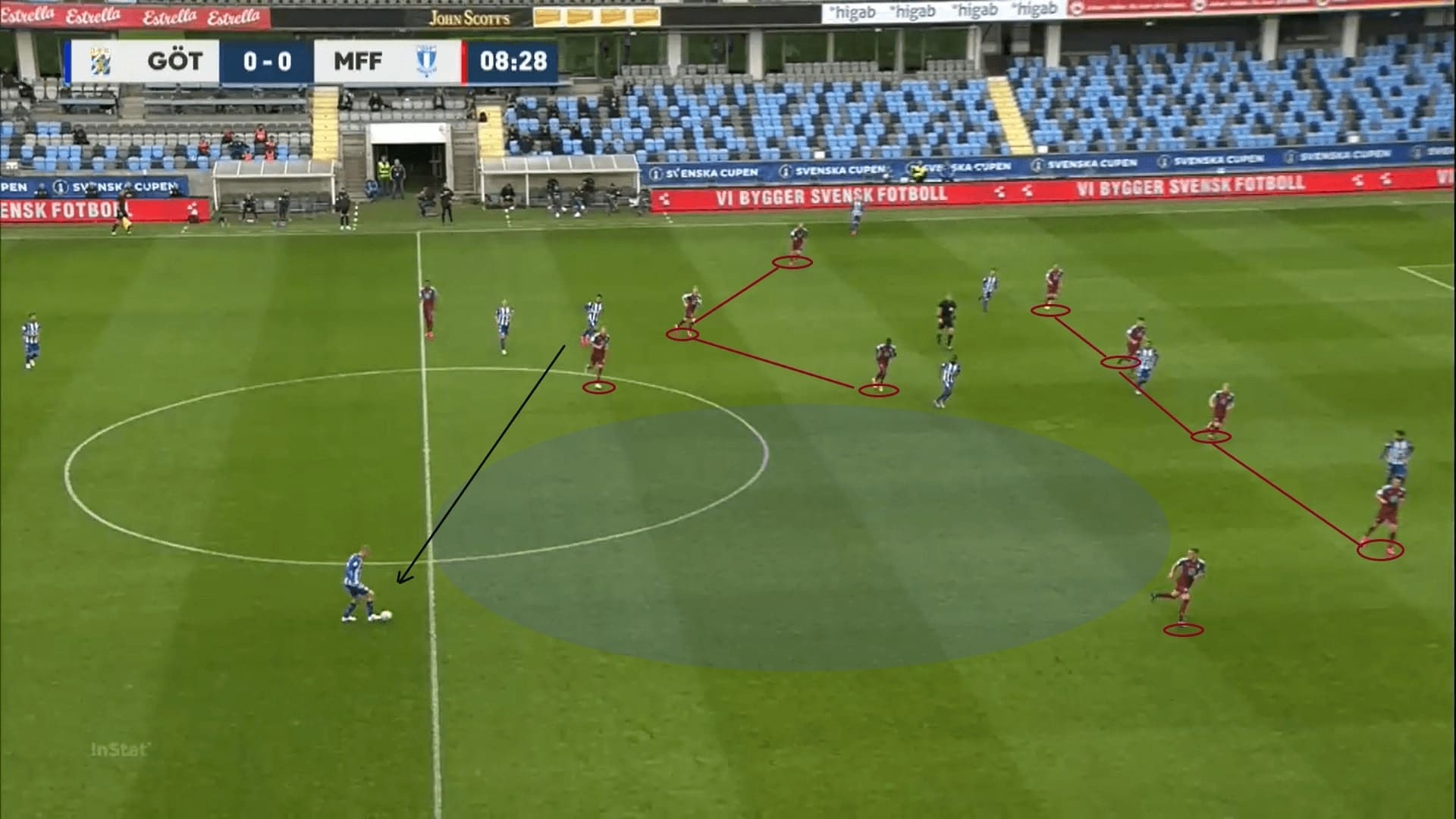
Apart from the wide full-backs, the use of false-wingers was also important in Göteborg’s attack. At times the attacking players were operating at spaces between the lines, manipulating the defence. These hole players were also able to connect plays when utilizing the positional superiorities.
For example, Jonas Knudsen knew the right-winger came narrow to receive the ball, but he just could not press him. The Blåvitt right-back was staying in the outer zone, close to the final third. The former Ipswich left-back was unwilling to jump to the receiver at the expense of leaving a free player nearby the final third.
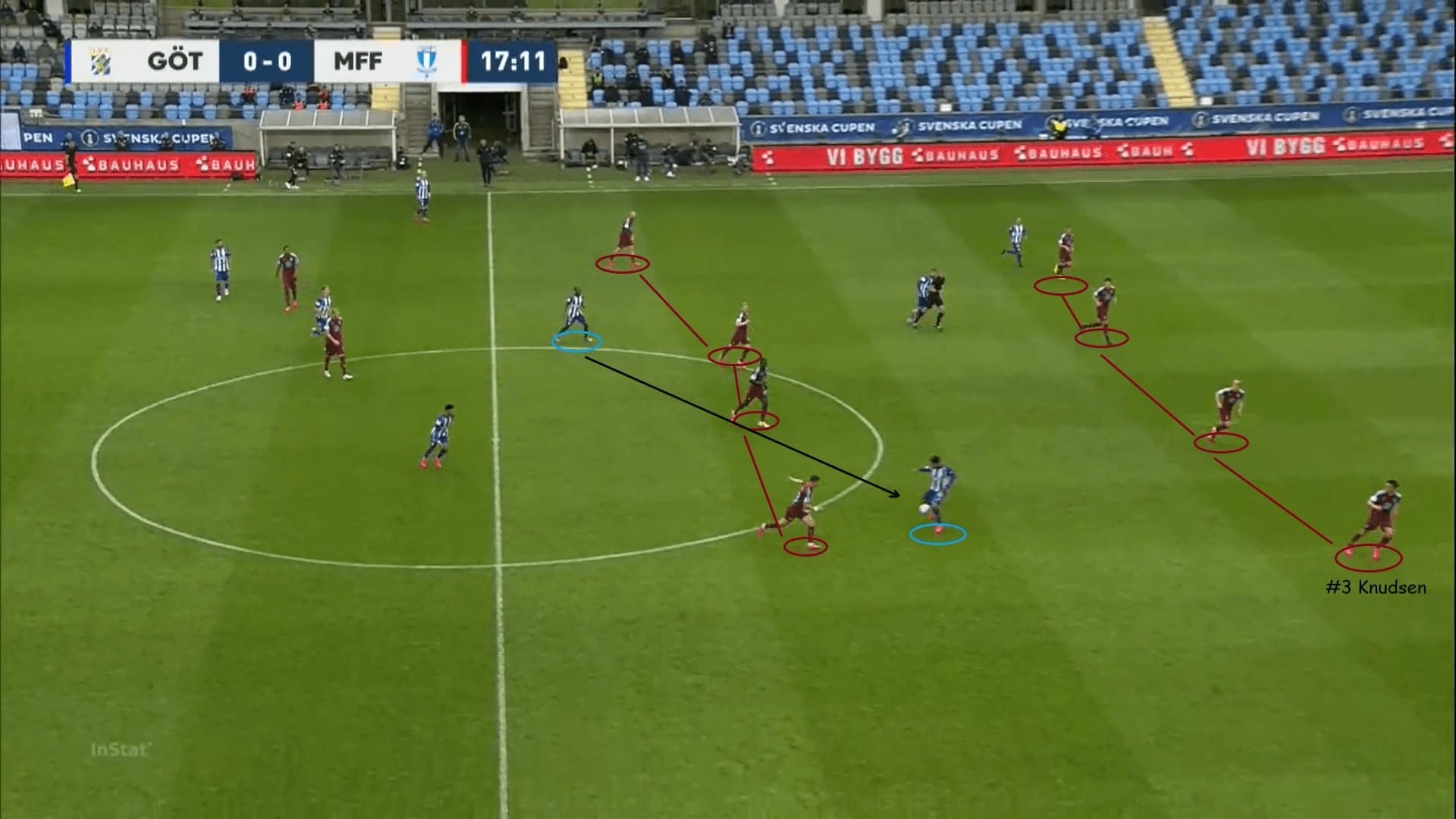
In the second half, it seems Göteborg has discovered some weaknesses of the opponents. The general attacking scheme was similar, using spaces between the lines, but the attack was more detailed, this included attacking flanks by numerical superiority.
Firstly, a common scenario was occupying the Malmö full-backs with a winger, this often manipulates Knudsen or Larsson’s position when developing the attack. This would leave the outer zone with more spaces for the full-backs. Benefiting from this setup, Jallow moved higher to attack more.
Another slight tweak was to invite Christiansen. As mentioned, the Malmö skipper was used to move out of his position. This means spaces was available behind him and all the attacking team needed is to use them. Göteborg were braver to find hole players by the forward passes, like this example.
Also, the defensive awareness of Antonsson was not as good as Rieks, at times he left Knudsen being isolated and it was not a favourable situation. Here, the duo was confused by who to mark and who to pressure the ball.
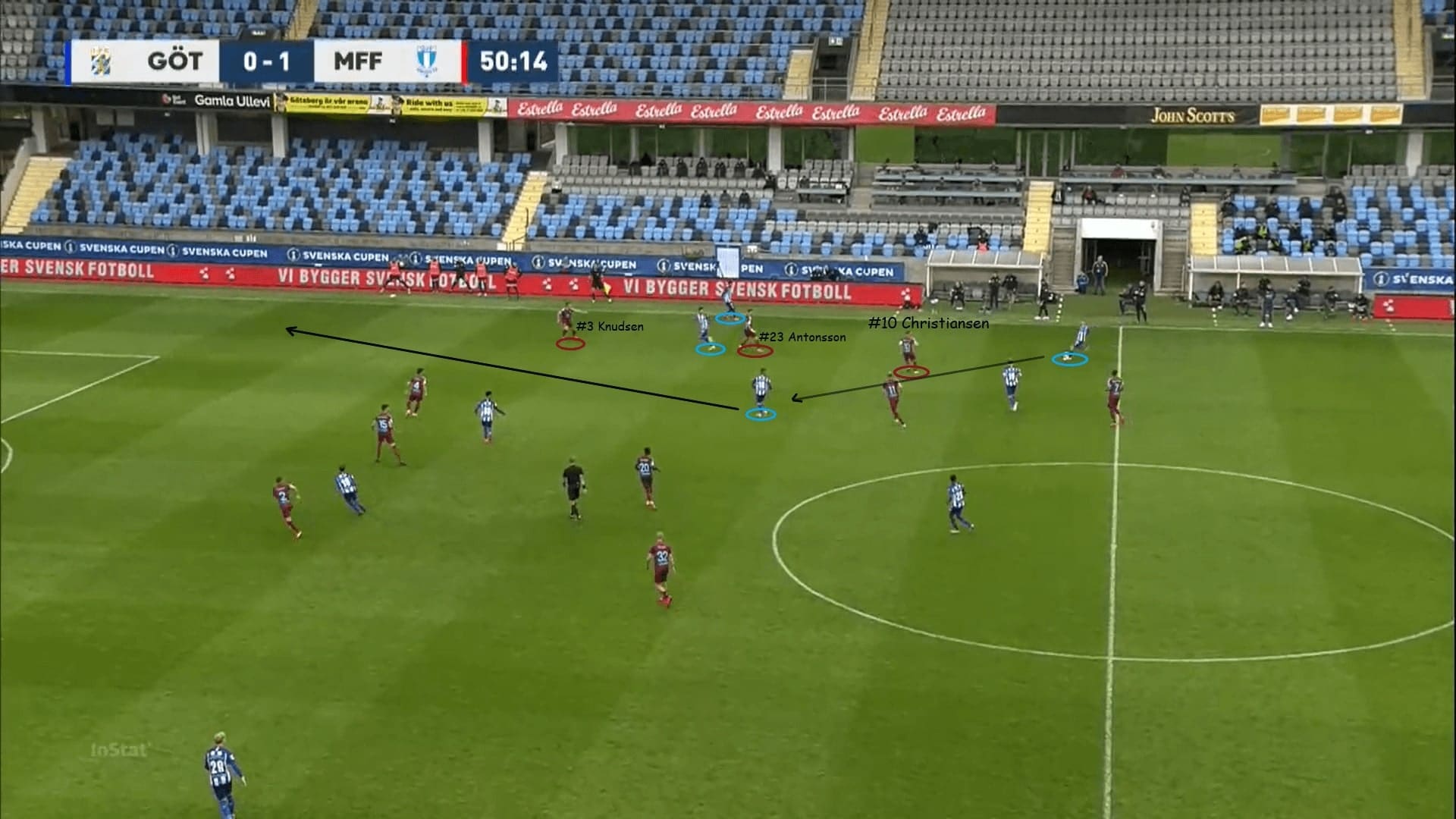
Another strategy of Göteborg was the diagonal balls. A similar concept was applied – occupying the Malmö full-back with the winger, this opened the outer zone for the attacking full-back. In this case, Knudsen was occupied as his attention was on the inverted winger. Jallow was free to receive the cross-field ball as a result. The intention of this setup is good, but a better execution is needed.
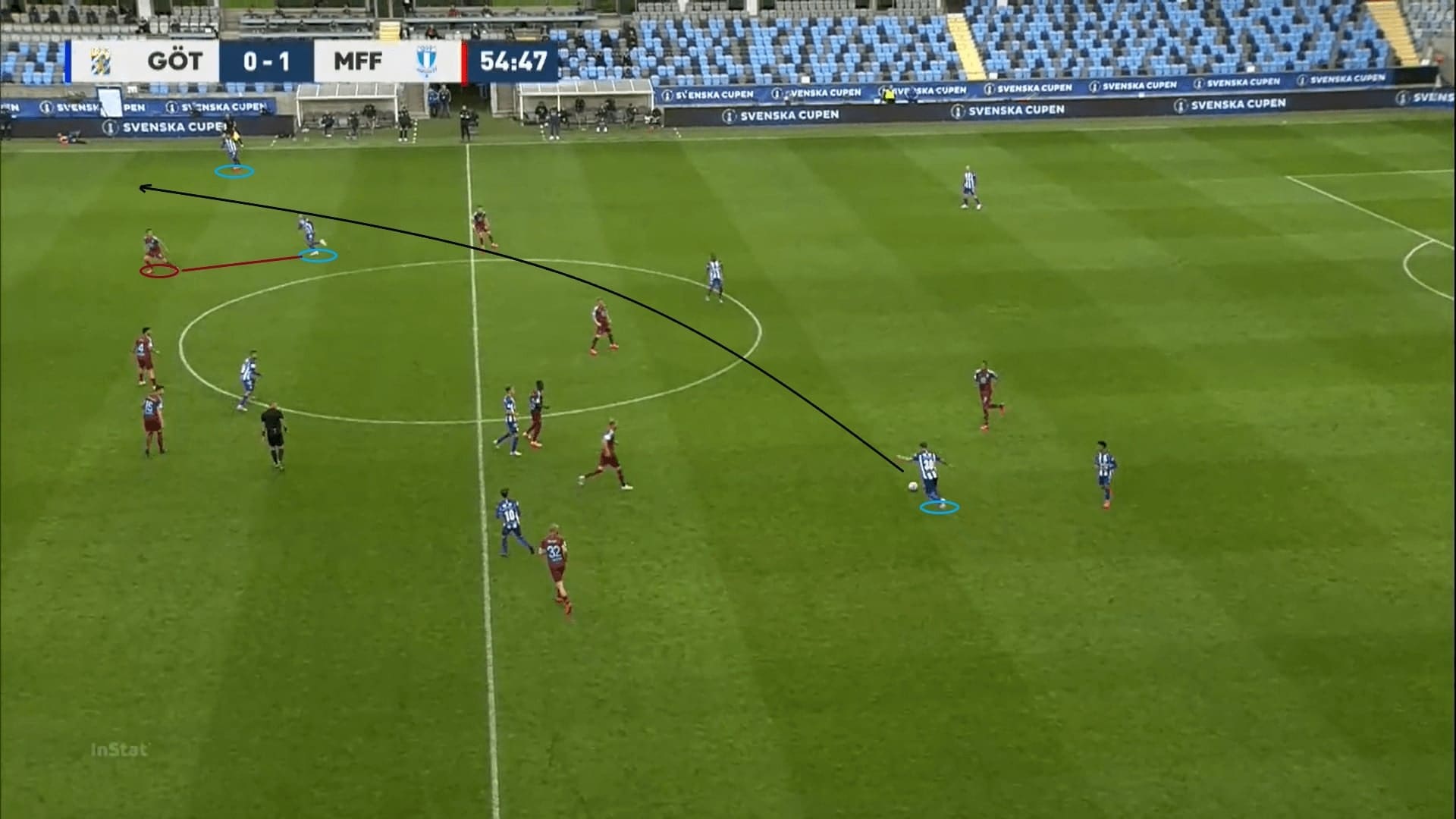
Transitions
Innocent was doing quite fine in terms of replacing Fouad Bachirou. The Nigerian midfielder was hardworking to pick the second balls, triggering the offensive transitions and moments to counter-attacks.
Of course, football is a team game and the counter-presses relied on the collective behaviour of every player on the pitch. As the skipper, Christiansen led by example to put instant pressure on the ball always, or at least, closing the options quickly, which was the situation in the below case.
The counter-pressing job was carried out by Kiese Thelin here, who cleverly curved his run to shut the central passing lane. This was a hint for Innocent, who could read the passing lane and direction early, hence, an easy decision was made (shifting from marking a player to collect the ball in that zone).
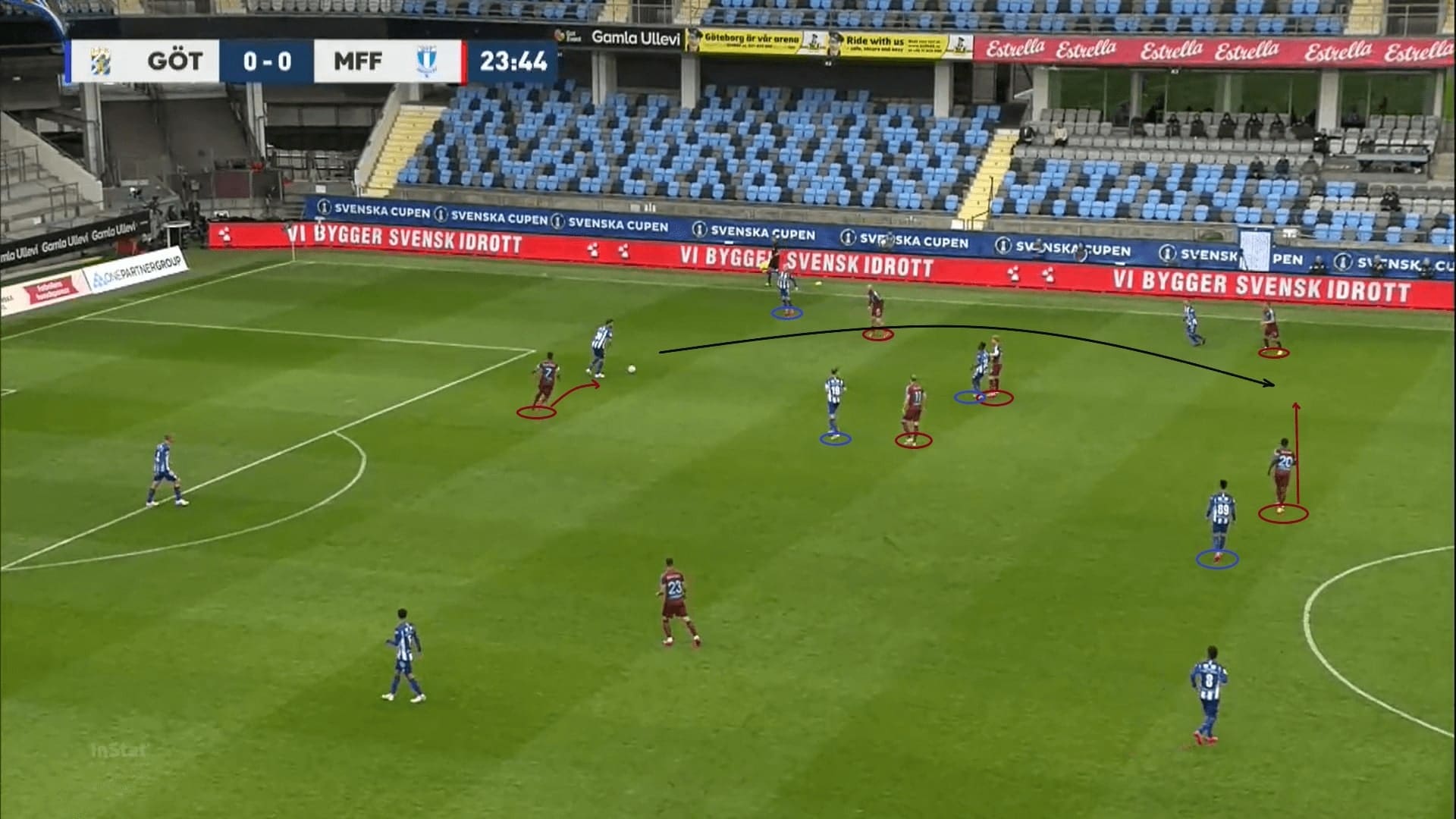
Once regained possession, Malmö tried to trigger the counter-attacks. A most-used route was finding Kiese Thelin directly. Through some long and direct plays, Di blåe intended to use the former Bayer Leverkusen striker as a target man, attacking the backline directly. On other occasions, hitting the ball to the wide areas was also an option, the likes of Antonsson, Rieks and Inge Berget were hardworking runners to chase those balls.
In this example, we are showing the value of the offensive transitions. Usually, the Göteborg tried opening the shape and the centre-backs were separated apart. Malmö were trying to exploit the gaps between the defenders before they recovered positions.
A worth-mentioning example would be the chance of Kiese Thelin before the break, this was a classic counter-attack as we have explained the process above. Toivonen fed a delicious through ball to the striker, who could run between the centre-backs. The Malmö #7 should have buried the chance.
If an instant passing option was not available, then, recirculating the ball to organize an attack was not a bad option. The backline was quick to open the shape and provide another option for the ball under these circumstances.
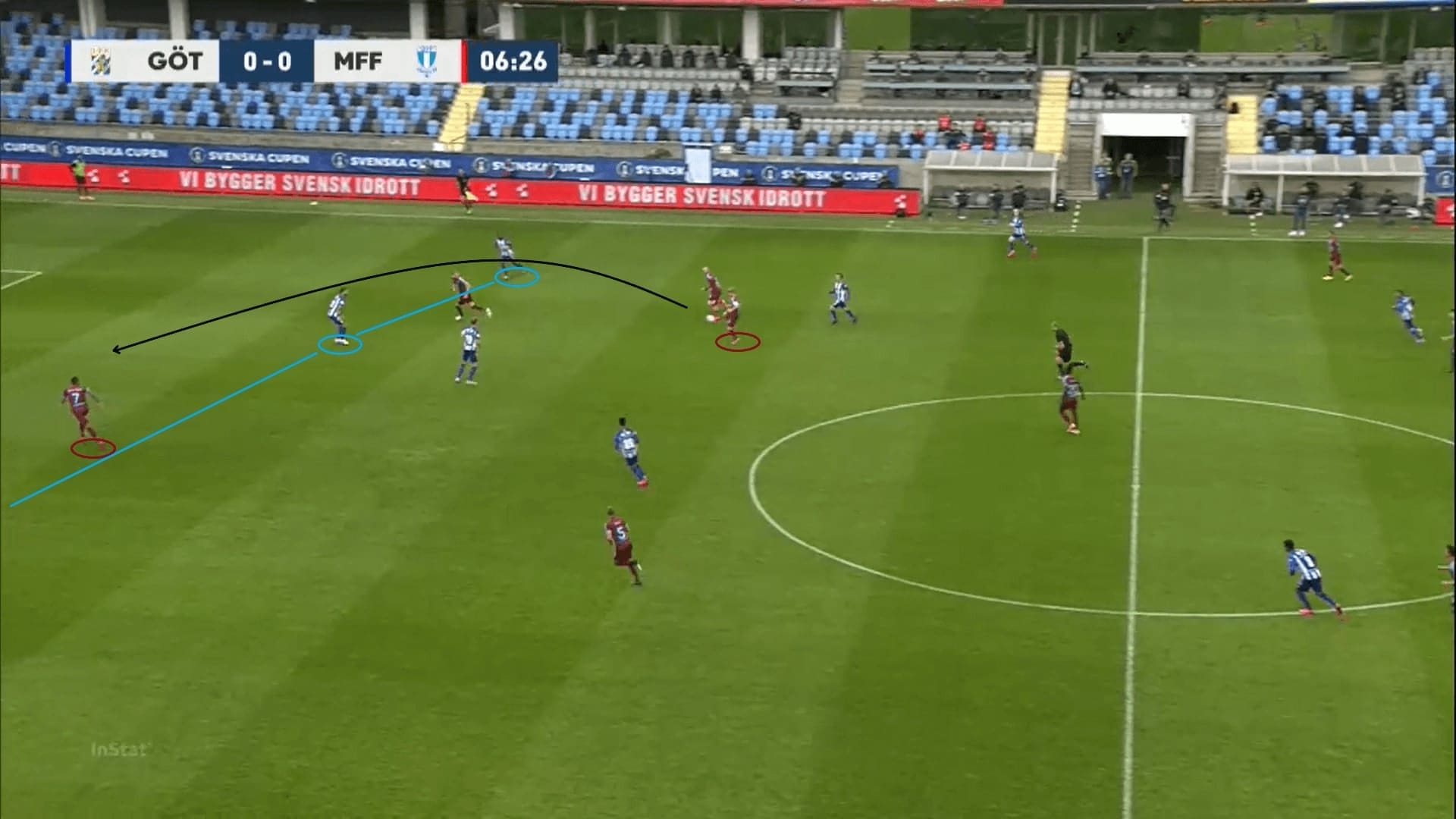
Final remarks
From a tactical standpoint, this is a very exciting game as there are a lot of tactics to investigate. Malmö might be a bit unlucky as two starters – Lewicki and Rieks injured even before the half-hour mark, which might disrupt the plan of Tomasson. Malmö were the better side in the first half, but the second half was a bit more difficult as the opponents were trying to equalize, the game was closer.
Malmö was not that bad, but they were not clinical enough in front of the goal. There were good moments, but also some bad moments which punished them. Now, Di blåe will have to regroup and come back on Sunday, against the sam opponent – Göteborg.





Comments